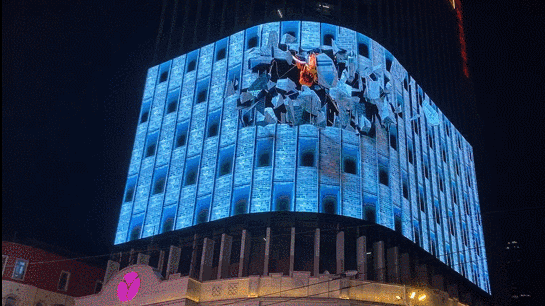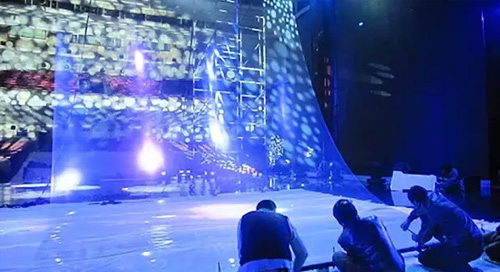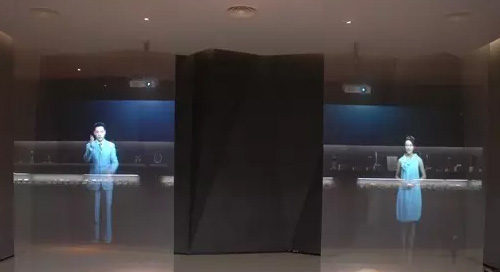It is understood that most of the naked-eye 3D LED technology display is in the research and development stage, and its research and development is divided into two directions, one is the research and development of hardware equipment, and the other is the research and development of display content processing. In the past few years, naked-eye 3D led displays have been launched from time to time, and they have become popular on major social platforms.
For example, in 2013, JYLED launched the first naked-eye 3D led display; in 2014, HOLA-LED also officially launched the naked-eye 3D led display; in 2015, 3D technology is no longer a special secret, so it has been led The major manufacturers of the display screen are competing to develop.
For example, Lingxingyu has specially launched a set of 3D solutions for 3D led display, and Yishida has launched a direct led display 3D conversion box. But in general, there are very few domestic companies that can independently develop naked-eye 3D technology LED displays.

Over the years, LED display manufacturers have never given up on the research and development of naked-eye 3D technology, but it will take a certain amount of time to achieve a large number of applications in the field of LED display applications and gain market acceptance.
Next, let’s talk about holographic projection, which is a technology that presents images in the air. In so-called technical terms, true holographic projection technology is a technology that uses the principles of interference and diffraction to record and reproduce real three-dimensional images of objects. In terms of implementation, there has always been a debate between “true holography” and “pseudo holography” in the industry.
The so-called true holography, to put it bluntly, is to display images in the air. However, as far as current technology is concerned, this is actually a false proposition. The holographic scenes that appear in sci-fi movies are actually post-production computer effects. All holographic imaging requires a signal light source and an imaging medium, and air cannot yet become an imaging medium, because light cannot be interrupted and intercepted out of thin air.
Now the presentation using various media on the stage is called “pseudo-holography”, and we will no longer do unnecessary entanglement of authenticity here.
For example the following:

At present, the commonly used holographic projection methods on the commercial stage can be roughly divided into two categories: one is the rear projection method, the projector directly projects the image onto the holographic film; the other is the use of reflection, which reflects the projection or LED image to a 45 On the holographic film placed at a high degree, the effect will be more realistic, and the cost and cost will be higher, which is used in large-scale parties.


In fact, it is a special kind of projection screen. This kind of projection screen uses a transparent film base, and an interlayer is sandwiched in the film base. Scale prisms are used to change the light path, and low-end and low-cost ones use a very fine but dense wire mesh to block the light path. Or a certain specification of coated glass, the effect of the coating is just right in the two parameters of reflectivity and transmittance, which is relatively balanced. Not only is not weak reflection, but also can transmit light.
No matter which method is used, the purpose is to make the projector’s light beam cast on the screen, it is a transparent film base from a distance, but the reflectivity is very high.
The result of this is that people who watch from a distance can only see the image floating in the air, but basically can’t see the transparent film base. This creates an optical illusion that the image is magically separated from the display medium and exists in the air. Even in a more ideal stage light environment, people will have the illusion that this is the real thing and not the image. Of course, if you see a video, it’s another matter, because there is a technology called post-production.
Projection reflection holographic stage production diagram:
The system is located in front of the stage, the projector is above the front of the stage, the ground below the front of the stage is designed as a high-brightness projection interface, and the material to be projected is imaged on the interface; from the stage entrance to the front and top of the stage, there is a A holographic film for reflective projection, the light is reflected and refracted on the holographic film, and finally forms an illusion on the stage. When designing and performing, it is usually necessary to protect the projection interface in front of and below the stage in a certain way. form a hidden space.
The Pepper’s ghost holographic projection technology mentioned by Zhang Yimou, the director of the G20 gala, is a similar situation.
Then another common holographic statement is the holographic projection of space, which is probably also a way of expressing madness, cool, mighty and domineering that thousands of people dream of, and many times many people claim that they have obtained such a future.
This is the cool three-dimensional holography in everyone’s mind, but it cannot be fully realized at present.
The domestic media will be popular abroad and domestic Magic Leap is also called 3D holography, in fact, it is the same AR technology as Hololens. The biggest difference between Magic Leap and Hololens should come from the display part. Magic Leap uses optical fibers to directly project the entire digital light field (Digital Lightfield) to the retina to produce the so-called Cinematic Reality (movie-level reality).
Hololens uses a semi-transparent glass, DLP projection display from the side, the virtual object is always real. Everyone must have seen the video of Magic Leap. This promotional video was shot by the camera through Magic Leap equipment, that is, light field glasses, using optical fiber projection technology.